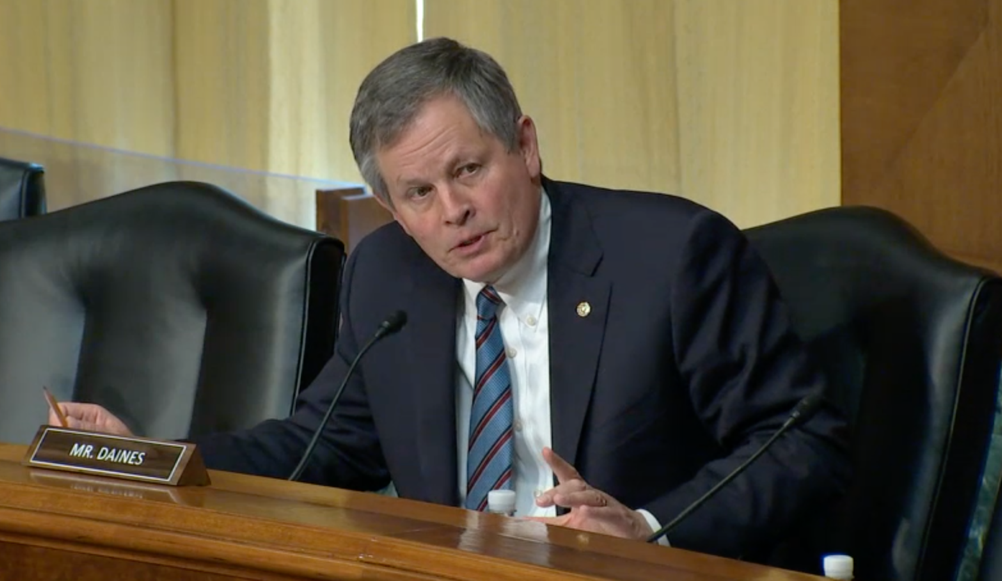U.S. Senator Steve Daines spoke at a Senate Finance Committee hearing, and emphasized the rapidly increasing number of fentanyl-related deaths in Montana as a result of President Biden’s wide-open southern border. Daines also highlighted the importance of community partnerships and peer support in the addiction recovery process.

Watch the exchange HERE.
“I’ve spent a lot of time on the southern border, sometimes going the night shift from 10:00 p.m. to 6:00 a.m., watching what’s happening. This vote this afternoon is a political stunt. If we’re serious about solving the crisis on the southern border, the Democrats should go down to the Commander-in-Chief, the Oval Office, and ask President Biden to reverse the reversal of the policies that he put in place of executive action after President Trump left office. It really isn’t that complicated…
“Border Patrol agents do not have enough resources. It’s a zero-sum situation. They’re apprehending nearly nine million illegals that come across the border since President Trump left office. And that allows the Chinese to ship the fentanyl precursors to the cartels, they manufacture them, and then ship them into the United States. In fact, by the time it leaves the Rio Grande until it gets to Montana is about 48 hours now with the efficiencies of the Mexican cartels. And what is going to happen this afternoon, frankly, will be seen by the American people as a political stunt in trying to save an election.”
Daines then asked the witnesses about the importance of substance use care and peer support.
Senator Daines: Last month, I co-hosted a discussion with Senator Cardin in the Finance Health Care Subcommittee on the opioid epidemic in our country. I’m glad the full committee decided to spotlight this issue as well. Driven by the man-made crisis at our southern border, fentanyl manufactured by Mexican cartels using the precursor chemicals from China have flooded across the border and they’ve been in every community in Montana and, sadly, across the nation.
We’re in a northern border state but we also have now a southern border crisis. In fact, in Montana alone, the state crime lab has preliminarily reported eighty overdose deaths involving fentanyl in 2023, an increase of 1,900 percent from 2017 when there were just four.
Although we have therapies and FDA approved medicines for treating substance use disorder, accessing this care has long been outside the traditional health care continuum, resulting in a fragmented system and a challenge for patients to navigate.
In the subcommittee’s work last month, it was apparent to me that the care provided for substance use disorder across the country is often a reflection of each individual community, its specific needs and the community partners available to help create local continuums of care.
Dr. Herron, could you share with the committee this hyper-local aspect of providing substance use care and the importance of community partnerships as well as coordination to treat patients?
Dr. Herron: Thank you for the question. Yes, I think I have an interesting perspective in that I work in a federally qualified health center in New York that includes urban sites, rural sites and suburban sites and the needs of each community are both different and the same. I think the access to evidence-based, high quality, low barrier treatment is shared among all people with addiction. But building those community partnerships in order to build trust, to build connections with additional resources, with schools, with recovery-oriented communities, with organizations that can help to do a lot of the preventive services you’ve heard about today are really essential.
And so understanding the needs of those different communities, whether they be the variable access to technology, to transportation barriers, differences in income levels and insurance demographics in each of those communities really do require a nuanced approach to the services you’re providing in that local environment.
Daines: Dr. Herron, thank you. I have one more question, final question, for Mr. Vezina. When Senator Stabenow and I led the Finance Committee’s efforts on the Mental Health Workforce Working Group, one of the proposals I worked on was increasing Medicare participation for peer support for individuals with mental health or substance use conditions.
Mr. Vezina, your organization provides a number of resources to individuals struggling with substance use and addiction, including peer support as well as mentorship. Could you speak briefly about the role of peer support in the substance use disorder care continuum, especially for our youth and our young adults?
Mr. Vezina: Yeah, thank you so much for the question. For hundreds of years, people in recovery have helped other people recover, and it’s been largely voluntary. The first drug and alcohol counselors were a lot of people in recovery. A lot of the evolution of how we treat addiction has been pushed by people in recovery and so this peer support occupation gives people in recovery a specific occupation to go out and motivate people to change. That’s what peers can do, they can help motivate people.
People who have addiction are oftentimes ambivalent; they want to quit and they want to use at the same time. And that’s a natural human kind of condition. I want to stop eating candy, and I want to eat a bunch of candy at the same time. I think everyone can share that duality.
And so peers really can help people motivate to change. And so at 4D, we have about 100 staff, and we have five recovery centers. And that’s all we do is go out and motivate youth and young adults to get into recovery and to sustain their- recovery. And so you can put peers in pretty much any setting and help people to get motivated to participate in the recovery process.
